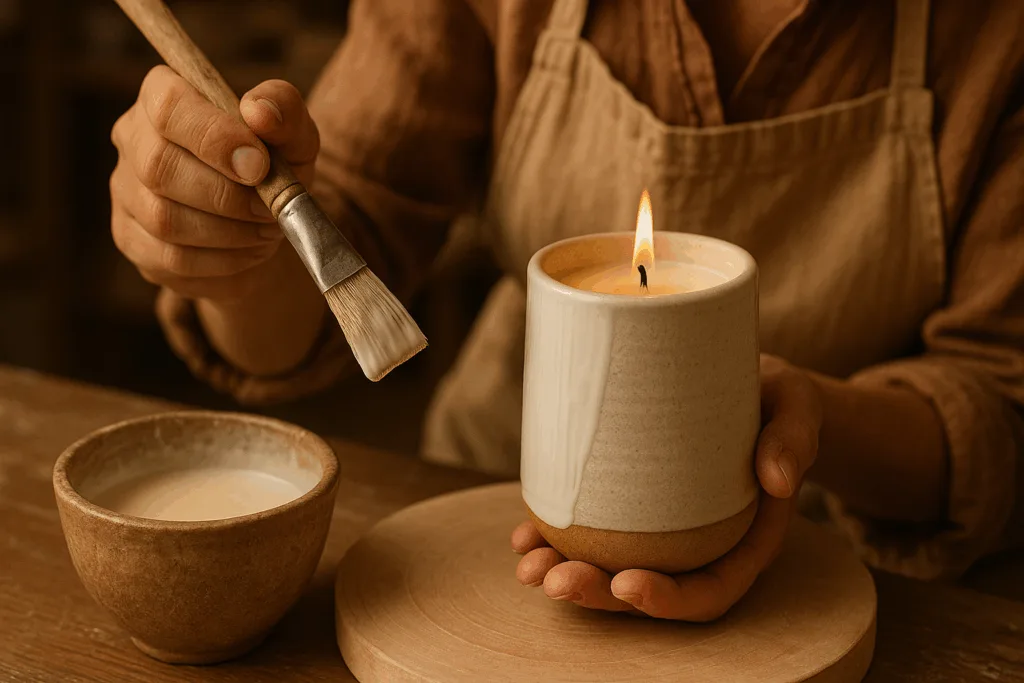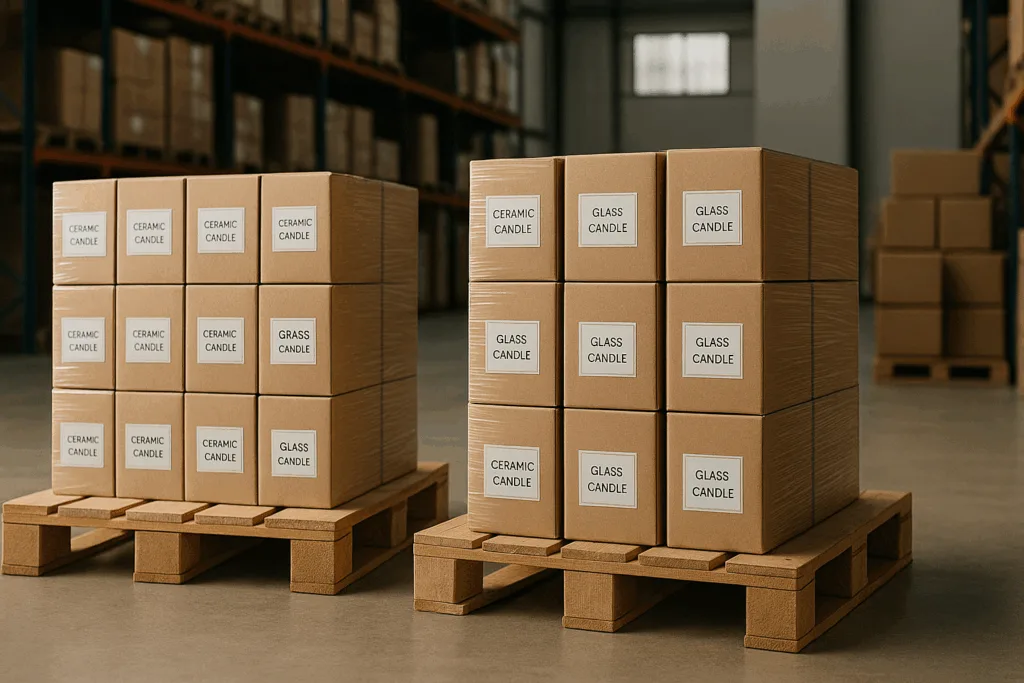Understanding Ceramic vs Glass Candle Jars in Modern Candle Branding
Choosing between ceramic and glass candle jars is more than a simple packaging decision—it defines the aesthetic, performance, and emotional identity of your brand. As candle consumers grow increasingly sophisticated, the vessel has become a central storytelling tool. It conveys luxury, purity, warmth, transparency, craftsmanship, minimalism, or artistry depending on the material.
Ceramic vessels speak to earthiness, handcrafted beauty, and sculptural form. They appear in boutique hotels, artisanal concept shops, wellness spas, and experiential retail spaces where sensory depth matters. Glass jars, meanwhile, provide clarity, shine, and classic appeal. They remain the global go-to for mass-market lines, scalable fragrance collections, and minimalist brands.
Understanding how material influences the consumer experience—and your production workflow—is essential for private-label buyers, wholesalers, and growing candle brands establishing their signature identity. This article explores every dimension of ceramic vs glass candle jars to help you choose the vessel that elevates your fragrance line.
Why Vessel Choice Matters for Premium Candle Lines
In luxury home fragrance, the vessel is the first tactile and visual impression customers experience, setting expectations long before the scent is lit. The material influences:
- Perceived value: Ceramic jars create boutique-level exclusivity; glass conveys timeless clarity.
- Brand storytelling: Materials act as design language—earthy vs minimal.
- Shelf appeal: The vessel determines impact on store displays, ecommerce photography, and social media.
- Customer retention: High-quality jars often get repurposed, keeping your brand visible.
Candle brands that invest thoughtfully in vessel selection often see higher customer loyalty, more frequent gifting purchases, and stronger social engagement.
Aesthetic Appeal: Comparing the Visual Impact of Ceramic vs Glass Candle Jars
Texture, Weight & Artisanal Feel of Ceramic Candle Vessels
Ceramic vessels provide a tactile richness unmatched by any other jar type. Because each ceramic piece can be hand-thrown, molded, or individually glazed, no two jars are perfectly identical. This slight variation becomes part of the charm, signaling craftsmanship and authenticity.
Ceramic finishes include:
- Matte earth tones
- Gloss glazes
- Crackle finishes
- Rough, stone-like textures
- Engraved or sculpted patterns
The weight of a ceramic candle creates a sense of substance and permanence. The vessel becomes a décor object—a sculptural piece worthy of reuse.
Transparency, Shine & Minimalist Elegance of Glass Jars
Glass candle jars bring lightness and purity. Their transparency allows consumers to see the wax color, botanical inclusions, or minimalistic styling inside the jar.
Popular finishes include:
- Crystal clear
- Frosted
- Amber
- Tinted color gradients
- Iridescent
Glass jars complement brands seeking:
- Modern minimalism
- Clean aesthetics
- Spa-like simplicity
- Mass-market consistency
The visual glow of a burning candle is also more pronounced in glass, making it ideal for brands that want candlelight to be a major part of the experience.
Heat Retention & Burn Performance Differences
The vessel material plays a significant role in how a candle burns.
Thermal Stability of Ceramic Vessels
Ceramic retains heat exceptionally well and distributes it evenly. This stable environment supports slower, more controlled melts, often extending burn time.
Benefits include:
- Reduced tunneling
- Consistent melt pools
- Enhanced warm throw
- Slightly longer burn duration
Thicker ceramic walls help protect the flame from drafts, improving consistency.
Heat Distribution in Glass Containers
Glass conducts heat more quickly and cools fast, impacting wick selection and burn behavior. While glass burns are predictable, they require careful wick testing.
Advantages:
- Excellent visibility of melt pool
- Reliable performance with most waxes
- Works well for single- and double-wick formats
However, thin-walled glass may heat unevenly if the wick is not properly sized.
Fragrance Throw: How Vessel Material Affects Scent Projection
Ceramic’s superior heat retention enhances warm throw, projecting fragrance effectively when the candle is lit. Glass tends to offer a better cold throw, since the open surface and nonporous material allow scent molecules to rise freely.
Ceramic: stronger warm throw for richer or heavier scents. Glass: stronger cold throw for bright, fresh, or airy fragrances.
Both materials perform beautifully when paired with high-quality wax and wick combinations.
Customer Perception & Brand Positioning Through Vessel Materials
Consumers read vessel materials as design signals.
Ceramic tends to communicate:
- Handmade luxury
- Artisanal craftsmanship
- Wellness or spa alignment
- Elevated décor value
Glass tends to communicate:
- Clean beauty
- Simplicity
- Mass appeal
- Everyday elegance
Your choice directly shapes your brand’s reputation.
Luxury Branding Advantages of Ceramic Candle Jars
Ceramic vessels naturally lend themselves to luxury lines. Their handcrafted look, weight, and texture suggest exclusivity and emotional warmth. Boutique brands, premium wellness studios, hotels, and spas frequently choose ceramic for limited editions or signature collections.
Ceramic jars stand out:
- In small-batch markets
- As statement pieces
- On interior design mood boards
- In luxury gift sets
They also hold long-term repurposing value, further reinforcing a sustainable, high-value brand image.
Mainstream & Mass-Market Flexibility of Glass Candle Jars
Glass is the most widely used vessel in the candle industry for good reason:
- It offers predictable supply chains.
- It scales endlessly with consistent quality.
- It provides universal consumer appeal.
- It maintains competitive retail pricing.
For brands focused on retail expansion or high-volume manufacturing, glass remains the most efficient and versatile choice.
Durability & Safety Considerations
Both materials are safe when produced to regulatory standards.
Ceramic advantages:
- Resistant to thermal shock
- Less likely to crack under heat stress
Glass advantages:
- Fully nonporous
- Chemically inert
Premium thick-walled glass performs exceptionally well in high-temperature environments.
Sustainability Analysis: Ceramic vs Glass Candle Jars
Eco-conscious consumers should consider the full lifecycle.
Recyclability & Upcycling Potential
Glass is widely recyclable through municipal systems. Ceramic is not easily recycled but offers long-term upcycling potential as planters, cups, organizers, or decorative pieces.
Eco-Footprint of Kiln-Fired vs Mold-Blown Vessels
Ceramic production requires kiln firing, which is energy-intensive. Glass production uses high heat as well but benefits from established industrial efficiencies.
Both materials have strong sustainability narratives depending on your brand emphasis—recyclability vs longevity.
Cost Structures & MOQs for Bulk and Private Label Buyers
Cost varies dramatically by design complexity and material.
Ceramic:
- Higher production cost
- Higher shipping cost due to weight
- Often higher MOQs due to artisanal workflows
Glass:
- Lower cost for standard designs
- Higher affordable scalability
- MOQs can be in the thousands, ideal for major retail lines
Your intended sales volume should guide your choice.
Packaging & Shipping: Weight, Breakage & Logistics for Both Materials
Ceramic is heavier but extremely durable. Glass is lighter but requires additional protection.
Ceramic pros:
- Less likely to shatter
- More resistant to impact
Glass pros:
- Lighter shipping cost
- Familiar handling standards
Correct packaging ensures safe delivery regardless of material.
Wax Compatibility: Soy, Coconut, Beeswax & Blends
Both materials work with all major wax types.
Ceramic excels with:
- Coconut wax
- Soy-coconut blends
Glass excels with:
- Beeswax
- Paraffin blends
Wax color and clarity also influence vessel choice—glass highlights the wax visually, while ceramic hides it entirely.
Wick Behavior & Burn Consistency in Each Vessel Type
Ceramic often requires slightly larger wicks due to heat retention. Glass jars typically work with smaller, more standard wick sizes. Both require thorough wick testing—no material eliminates the need for proper burn trials.
Private-Label Customization Opportunities
Custom Colors, Glazes & Sculptural Shapes for Ceramic
Ceramic is unmatched when it comes to artistic expression. Brands can request:
- Custom glazes
- Special shapes
- Embossed patterns
- Multi-color finishes
- Handmade aesthetics
Frosting, Tinting & Label-Friendly Surfaces for Glass
Glass offers endless finish customization:
- Frosted matte
- Gradient tints
- Metallic coatings
- Silk-screen branding
- Engraved logos
These provide cost-effective consistency for multi-SKU collections.
Ceramic vs Glass Candle Jar Trends in 2025 Luxury Home Fragrance Market
Current trends include:
- Sculptural ceramic silhouettes inspired by pottery arts
- Earth-tone matte finishes in ceramics
- Minimalist, frosted glass with neutral branding
- Gender-neutral vessel designs
- Sensory-driven packaging focused on texture
Consumers seek authenticity, craftsmanship, and sustainable luxury.
Case Study: Premium Ceramic Line for Boutique Hotel Brand
A boutique hotel group partnered with us to design a coastal-inspired ceramic candle collection for guest suites and retail. The matte, sand-dune glaze paired with coconut wax created a serene mood.
Results:
- 35% increase in gift shop candle sales
- Guests reusing vessels as décor
- Enhanced brand storytelling through artisanal craftsmanship
Case Study: Scalable Glass Jar Line for Global Retail Chain
A major international retailer required millions of candle units annually with consistent quality. We designed a modern gradient-tinted glass collection.
Benefits:
- High-volume scalability
- Reliable global production
- Lower per-unit costs
The glass line became a bestseller across three continents.
Consumer Experience: How Each Material Shapes Ritual & Mood
Ceramic creates a cozy, enveloping ambiance—perfect for rituals of calm, slow evenings, and meditative spaces. Glass amplifies candlelight, perfect for bright, airy homes and minimalistic interiors.
Customers purchase candles as emotional experiences, and vessel material plays a crucial role in that sensory journey.
Common Mistakes Brands Make When Choosing Candle Vessels
- Choosing aesthetics before testing burn performance
- Underestimating shipping weight
- Ignoring target customer lifestyle preferences
- Overlooking wick adjustments needed for ceramics
- Assuming glass is always cheaper (not true for custom finishes)
Avoiding these pitfalls ensures smoother production and stronger brand identity.
Hybrid Strategy: When a Brand Should Use Both Ceramics and Glass
Many successful brands create parallel collections:
- Ceramic for luxury or seasonal lines
- Glass for core, volume-driven collections
This approach broadens your audience and price range.
Decision Framework: Which Vessel Works Better for YOUR Brand?
Choose ceramic if your brand values:
- Artisanal storytelling
- Sculptural décor
- High-end gifting
- A warm, tactile experience
Choose glass if your brand values:
- Clean, modern aesthetics
- Scalability and consistency
- Lower costs
- Classic candlelight visibility
Your brand identity should guide the vessel—not the other way around.
Conclusion: Final Recommendations & Partnership Invitation
Both ceramic and glass candle jars offer compelling advantages. The best choice depends on your brand’s aesthetic, sustainability goals, pricing strategy, and target audience.
Ceramic is ideal for boutique luxury. Glass is ideal for scalability and transparency. Many successful brands use both to tell a richer product story.
If you’re ready to develop your signature collection, Circe Home is here to collaborate and guide you through every step—from vessel selection to fragrance development to packaging.
Let’s build a candle line your customers will love, collect, and remember.
FAQ Section
What are the main differences between ceramic and glass candle jars?
Ceramic offers artisan charm and excellent heat retention, while glass provides clarity, simplicity, and recyclability.
Which is better for fragrance throw?
Ceramic vessels enhance warm throw, while glass excels in cold throw.
Are ceramic candle jars safer than glass?
Both are safe when produced to standards. Ceramic resists thermal shock well; high-quality glass is equally reliable.
Do ceramic and glass vessels affect burn time?
Yes. Ceramic often extends burn time due to heat retention.
Which is more sustainable?
Glass is easier to recycle, while ceramic provides long-term reuse and durability.
Can my brand use both materials?
Yes. Many brands use ceramic for luxury lines and glass for scalable collections.





